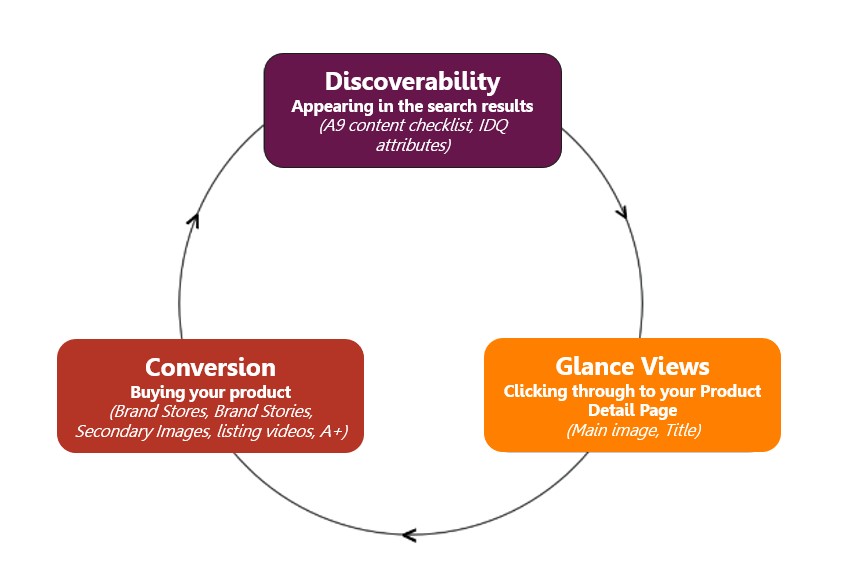Listing Optimisation is key to success on Amazon
Ask yourself this question: when browsing on Amazon, how many times have you searched for a product and clicked beyond the first results page? Maybe occasionally, if ever? You’re not alone. Jungle Scout reports that products on the first page get 80% of all clicks, and that the first three listings on page 1 get at least 60% of those clicks. Although these seem like scary statistics, there are ways to ensure your products have land in the top search rankings and benefit from that increased visibility. The secret? Listing optimisation informed by the A9 Algorithm and IDQ Score (Item Data Quality).
The Amazon Flywheel

Firstly, a quick definition of a flywheel – it is a rotating wheel that is installed as part of a machine to gain momentum, it’s challenging to get the flywheel moving. Initially it takes a tremendous amount of force to turn due to its heavy weight, but once turning, the momentum builds making it accelerate faster eventually providing a stable, consistent and robust force without further assistance.
Selling on Amazon is very similar. Getting your listings seen, clicked on and converted is the same challenge as getting the wheel in motion, but once all the components work together sales increase, providing more visibility, providing more sales and so on…

The two key components required to make this happen are the A9 Algorithm and the IDQ (Item Data Quality) Measure.
A9 Algorithm

Amazon’s A9 Algorithm decides how products rank in organic search results on the platform. It is designed to take a customer’s search and scan the site for the most relevant product, based on the content of the listing.
So how does it work?
A product will rank higher depending on how relevant Amazon considers it compared to the customer’s search. Things the A9 looks for to rank highly on the search page:
- Sales History/Conversion Rate
- Reviews
- Keywords that match the customer search contained in product title, bullet points and product description
- Click Through Rate
- Images/Videos
- Price
- Stock availability
It’s obvious that good sales are going to get products into the higher rankings. The more products that sell, the more reviews it is likely to receive, which further secures the product’s ranking position. However, the first step in this process is ensuring the listing information is engaging and accurate. Fundamentals first: Optimised titles, bullet points and product descriptions are vital in obtaining customer clicks. The use of relevant keywords across the item detail page all sets up the flywheel methodology; each element of the process both aids and heavily relies on the other to achieve success. Once the listing is optimised it will increase sales, which in turn increases the number of reviews. Increases in sales and reviews will trigger Amazon’s A9 algorithm to view it as more relevant to shopper searches. This will push it higher in search rankings. And we are back to the start!
It is important to note that stock availability plays a big role in listing visibility. Without stock the flywheel will lose momentum and the process of getting it moving must start again!
IDQ
The Item Data Quality report looks at the quality, accuracy, and presence of your content on an item detail page. Amazon analyses a listing and provides a score from 0-100 based on the attractiveness of the customer experience. The higher your IDQ score, the better Amazon deems your listing, which therefore makes it more shoppable to customers and increases conversion. The score provides an insight on what customers are missing from your listing and simple solutions to improve it.
Every element of a listing is assessed in the IDQ Score, including:
- Titles – inclusion of brand name and title length
- Images – number of images and image quality
- Bullet Points
- Product Description
- Keywords
- Relevant Attributes – form, size, colour etc…
- A+ Content
- Has leaf node
If a product scores below 90 on the IDQ, it won’t be included in Amazon’s algorithm, which decreases its discoverability. But we need to be careful; although Amazon will score products according to the presence of these features, it is vital that the quality of the content is not discarded in the pursuit of achieving a high IDQ score. It is more important that the information on an item detail page is accurate and relevant, than just having a placeholder there to boost a score.
A9 Algorithm and IDQ working together

As you can see, there is a clear overlap in what the A9 Algorithm looks for compared to what the IDQ analyses. A successful listing is one that has been optimised with both the A9 Algorithm and IDQ in mind. A product at the top of Amazon’s organic search page results takes full advantage of the IDQ – optimised fully and regularly monitored to ensure no shopper questions are left unanswered. In return, these optimisations mean that content is more accurate and engaging; leading to clicks, which leads to sales.
More sales on accurate listings increases positive reviews. All of this leads to Amazon realising the relevance and success of your product and pushes it into that first search page, until it sits at the top. Essentially, we are inputting all this information to train Amazon to think of your product first from just a few keywords a customer might type in. Therefore, it is crucial to have correct and complete listings. If a product isn’t included in the algorithm, it won’t appear in the search rankings, subsequently breaking the cycle.
Conclusion
At MinsterFB, we know that a listing needs to be in top shape from the get-go. Without having a good quality listing, it is pointless trying to achieve success utilising the SEO practises of the A9 and chasing after a strong IDQ score. However, with secure knowledge of the A9 and IDQ working behind the scenes, we know how to optimise a listing to its maximum potential. We understand that the A9 and the IDQ are crucial for listing optimisation; knowing how they work, both separately and together, allow us to give an ASIN the best chance of getting into those first search rankings.
So that flywheel we keep mentioning? We may sound like a broken record, but it’s at the heart of each process when selling on Amazon, and this is no exception. Because we understand the logic behind it, we have developed our practises to efficiently optimise listings to keep up the momentum.